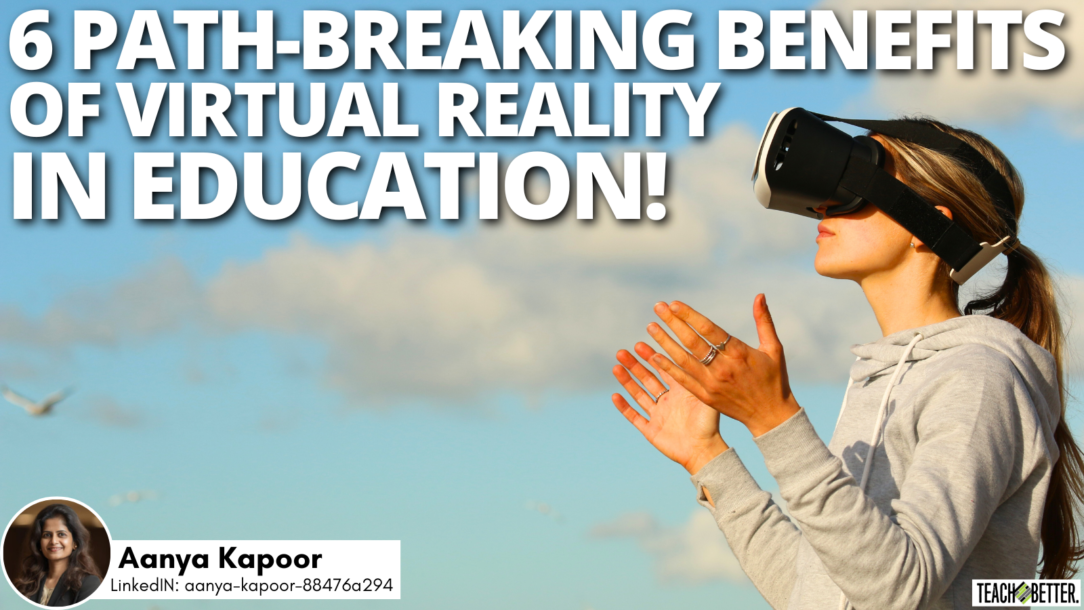TL;DR:
- VR revolutionizes education by offering immersive learning experiences, transforming traditional teaching methods into interactive and engaging lessons.
- It enhances engagement by allowing students to experience subjects firsthand, significantly improving retention compared to conventional methods.
- VR benefits all students, including those with disabilities, making education more inclusive and accessible while also providing cost-effective alternatives to traditional resources like textbooks and field trips.
If you are an educator who is connected with the modern world, you know that the importance of virtual reality in education is undeniable! But do you wonder about what all Virtual Reality (VR) can contribute in the classroom? Well, you are in for a treat because this post is all about the exciting world of this education technology trend.
VR is upending everything by delivering incredibly immersive experiences directly into classrooms. It is transforming how you educate and provide students with more exciting and interactive methods to learn.
It’s not only about piquing students’ attention. It’s about establishing an entirely new type of learning environment that is more entertaining and helps students do better in their studies. So, buckle up and get ready to explore the possibilities of incorporating this cutting-edge technology into education!
Top 6 Benefits of Virtual Reality in Education
The use of virtual reality in the Indian and global education systems is resulting in a significant change towards more dynamic and interactive learning experiences. Check out these top 6 ways in which VR is transforming the education system for good!
1. Increase in Engagement in the Classroom
Students in typical courses struggle to understand complicated concepts and theories based only on illustrations and explanations. This is due to the fact that even if they see something in a picture, they must still visualize it in their brains.
However, with VR and AR (Augmented Reality), kids can completely experience other worlds and perspectives. They get to interact with the content rather than just hearing or reading about it. It’s also supported by statistics: Pupils recall 20% of what they hear and only 10% of what they read. However, they remember 90% of what they learn via experience!
With VR (Virtual Reality) and AR (Augmented Reality), kids can completely experience other worlds and perspectives. They get to interact with the content rather than just hearing or reading about it. - Aanya K. Click To Tweet2. Exposure & Availability for All
Education should be available to all in an ideal world. However, in the real world, not all students have the resources they require. VR is altering this by providing students with access to a world of information. Education technology trends like VR and AR improved remote learning, particularly during the pandemic.
It makes instruction more realistic and enjoyable than simply being on a video conference. Students who suffer constraints in traditional schooling may use virtual reality to explore and learn any subject they desire.
3. Support for Differently Abled Students
VR has completely transformed the way children with impairments study. It is one of the most significant benefits of virtual reality in education. It’s not just about removing physical obstacles! It’s about establishing a personalized learning environment that meets the specific requirements of each student.
With VR, traditional teaching methods no longer pose a challenge for differently abled knowledge-seekers. VR opens up a world of opportunities that were once out of reach. It’s like unlocking a whole new dimension of learning!
4. Field Trips Made Easy
VR can take students on these amazing virtual field trips. It provides them with an immersive and participatory experience without requiring them to leave the classroom. Imagine exploring ancient ruins, plunging to the depths of the ocean, or even travelling across space from the comfort of a school.
It’s like the ultimate field trip but without the trouble of planning and spending. It’s also a really great method to make learning more engaging and enjoyable.
5. Greater Creativity in Learning
Imaginations tend to fade as students age. But VR is shifting that dynamic. It delivers a highly immersive atmosphere that truly brings creativity to life. It’s like unlocking their real creative potential. This surge in creativity in school and college kids reinstates the importance of virtual reality in education.
Students may use VR to explore the insides of ships, human anatomy, and even ancient artifacts right from their seats.
[scroll down to keep reading]
6. Cost-Effective Resources in the Long Run
You might be thinking that all these benefits of virtual reality must come at a high cost. Yes. The initial expense of incorporating VR into education may be higher. Still, in the long term, it is a cost-effective investment. You may save a lot of money over time by eliminating the need for tangible resources like textbooks and field excursions.
So, while VR may appear to be an expensive investment at first, it might really be a wise financial decision for schools. In fact, virtual reality can enrich education in India and other developing countries by lowering the need for resources.
To conclude, VR, along with other cool tech trends like the metaverse and augmented reality, have the power to change the way you learn and teach. It’s super immersive and makes learning really exciting.
Plus, it gets students more involved, makes learning more accessible, and could even save money in the long haul. Virtual reality brings tons of educational benefits for students and teachers alike. So why wait? Jump into this tech revolution now!
About Aanya Kapoor
Aanya Kapoor, is a content marketer with Extramarks. Along with her team, she develops content relevant to the 21st-century education ecosystems. Her content revolves around topics such as smart learning technology in education, modern parenting, as well as other education topics. Her writing combines her knowledge and personal interests, making her a valuable resource for those seeking insights into education and parenting. Beyond her professional expertise, she’s an avid reader, a globe-trotter who explores diverse cultures, and a passionate gardener.



